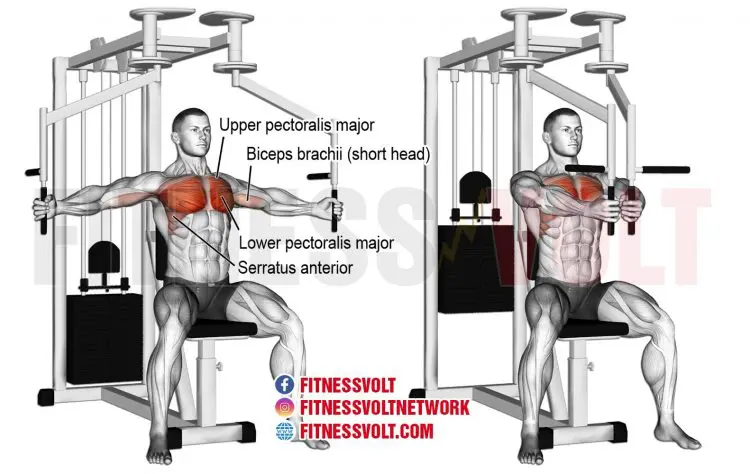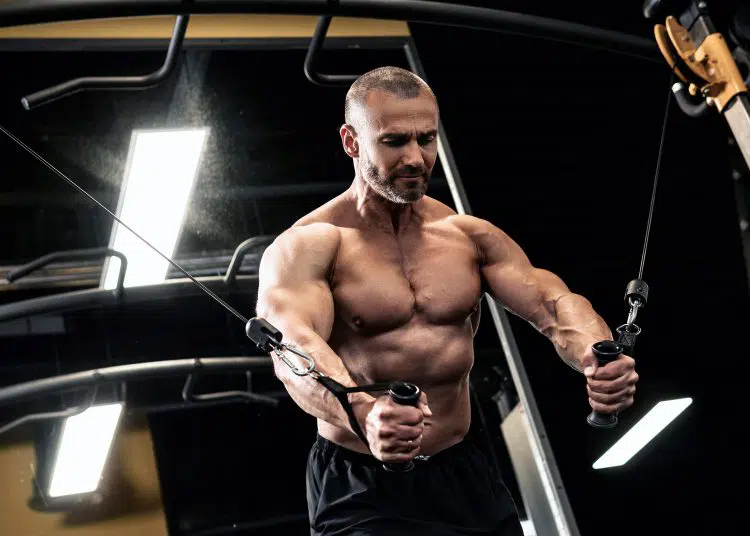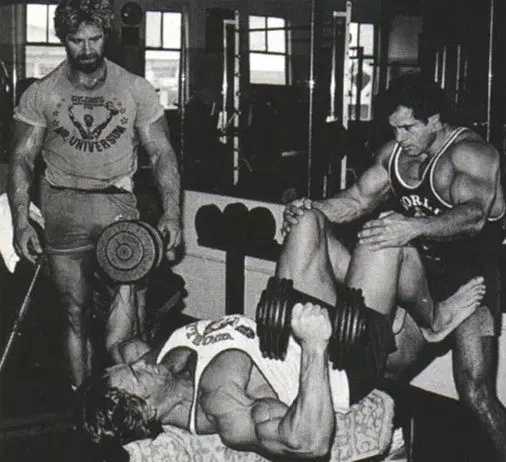Go to any gym almost anywhere in the world on a Monday, and you’ll see exercisers celebrating Chest Day (not an actual holiday!). Most bodybuilders prioritize their pecs by training them at the start of the week.
Whether they realize it or not, this is the Weider Priority Principle in action. According to Master Blaster Joe Weider, the best way to bring up any lagging muscle is to work it at the beginning of your training week, when your energy levels are highest. Also, by training your chest on a Monday, you’ll have time to train it again later in the week if necessary.
Invariably, Chest Day means bench presses. But, while the bench press IS an effective chest exercise, you’ll need to do other movements to create the ultimate chest. So, while compound pressing exercises are beneficial, your pec workout should include some isolation exercises too.
In this article, we reveal how to use the pec deck machine and provide you with some tips and alternatives to help you get even more from your chest training.
Pec Deck Muscles Worked
The pec deck is an isolation exercise, which means it involves movement at just one joint. Isolation exercises tend to work fewer muscles than compound movements.
The main muscles involved in the pec deck are:
Level Up Your Fitness: Join our 💪 strong community in Fitness Volt Newsletter. Get daily inspiration, expert-backed workouts, nutrition tips, the latest in strength sports, and the support you need to reach your goals. Subscribe for free!
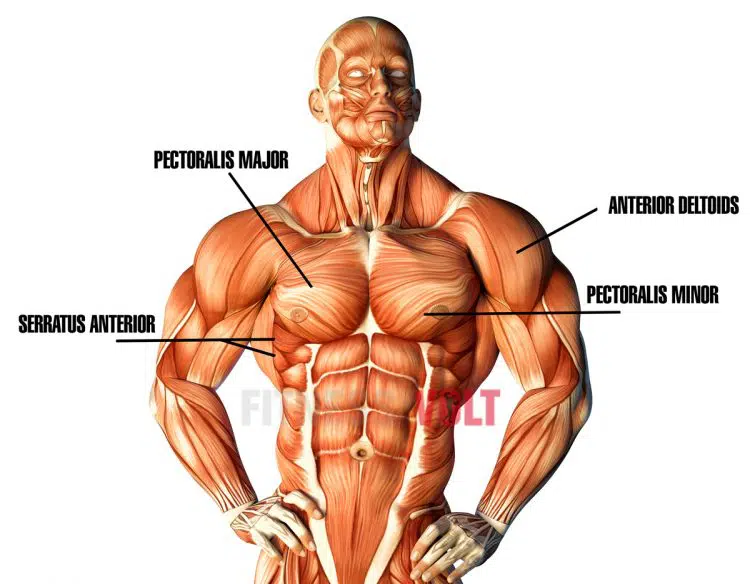
Pectoralis major – known as your pecs for short, this is your primary chest muscle. Located on the front of your upper torso, the pecs are responsible for horizontal flexion and medial rotation of your shoulders. The pecs are the agonist when using a pec deck, which means it is the prime mover and why most people do this exercise.
Pectoralis minor – pec minor is a thin, flat muscle that lies underneath the pec major. It assists your pec major during the pec deck and also prevents your shoulders from lifting.
Anterior deltoids– located on the front of your shoulders, the anterior deltoids work with your pecs to flex your shoulder joint.
Serratus anterior – the serratus anterior lies along the sides of your chest, above your first eight ribs. Its main function is holding the scapula or shoulder blades flat against your torso. When well-developed, and if you are lean enough to see it, this muscle looks like the edge of a serrated knife, which is how it gets its name.
How To Use the Pec Deck
Get the most from the pec deck while keeping your injury risk to a minimum by following these instructions. Please note that pec deck machines vary by manufacturer, so seek advice from a trainer if you are unsure how to use the pec deck at your gym.
- Adjust the seat so that, when you sit on it and grip the handles, your elbows are level with your shoulders and your upper arms are parallel to the floor. Select a light to moderate weight.
- Sit on the machine and place your feet on the floor or the footrests. Reach up and back and grab the handles. Place your forearms against the arm pads.
- Pull your shoulders down and back and brace your abs.
- Without jerking or leaning forward, smoothly squeeze your arms together until the machine arms touch lightly in front of your chest. Pause for 1-2 seconds.
- Open your arms and return to the starting position, stopping just short of touching the weights together.
- Repeat for the prescribed number of repetitions.
Pec Deck Benefits and Drawbacks
The pec deck is a valuable chest exercise with several notable benefits:
An effective pec workout
According to studies by the American Council on Exercise, the pec deck is one of the top three chest exercises (1). Only slightly less effective than the bench press, if you want to maximize pec muscle fiber recruitment, the pec deck is the exercise to do it.
Train your pecs without your triceps
Barbell and dumbbell bench presses are great pec exercises, but they also involve your triceps. Weak, tired triceps may mean your set ends prematurely, leaving your pecs under-stimulated. The pec deck does not involve your triceps, so you can work your pecs to failure without limitation.
Safety
Training to failure will help you build bigger muscles. However, it can also be dangerous, especially if you work out with free weights. The pec deck is a relatively safe exercise because, on reaching failure, you can simply return to the starting position without having to worry about dropping a heavy bar across your chest.
Easy to learn
The pec deck is a very accessible exercise. Your movement and the weight is guided by the machine, so it’s pretty hard to do incorrectly. This makes the pec deck a great movement for beginners.
A no-brainer exercise
Because your movements and the weight are guided during the pec deck, you are free to focus 100% on lifting and lowering the weight. This can be useful if you want to train your muscles to failure without worrying about coordination and balance.
Perfect for drop sets
Pump up the intensity of your workout by training to failure, reducing the weight by 10-20%, and repping out again. Repeat this cycle 2-3 times to fully exhaust your chest. Most pec decks have selectorized weight stacks, which makes them ideal for drop sets.
While the pec deck is mostly beneficial, there are a few drawbacks to consider too:
Shoulder joint stress
The pec deck can be hard on your shoulder joint. It places your shoulder in external rotation and horizontal extension at the same time, which can feel uncomfortable. If you have a history of shoulder pain, the pec deck could make things worse. Also, take care not to use too large a range of motion, which could also lead to painful shoulders and injury.
Not a very functional movement
While the pec deck provides an effective chest workout, it does not mirror how these muscles tend to work in nature. The pec deck is a good bodybuilding exercise, but it’s not as useful for athletes or anyone who wants to build functional strength.
Pec Deck Tips
Get more from the pec deck with these handy tips!
Push with your forearms and not your hands – keep your forearms pressed against the arm pads when using the pec deck machine. Pressing with your hands may allow you to lift more weight but reduces the range of motion at your shoulder, taking work away from your chest. Try to keep your hands relaxed and squeeze your elbows together.
Level Up Your Fitness: Join our 💪 strong community in Fitness Volt Newsletter. Get daily inspiration, expert-backed workouts, nutrition tips, the latest in strength sports, and the support you need to reach your goals. Subscribe for free!
Pause for 1-2 seconds mid-rep – maximize muscle tension by squeezing your elbows together and holding them there for 1-2 seconds per rep. This is the Weider Peak Contraction principle and will make your workout even more productive.
Adjust your starting position – some pec deck machines have foot levers that make getting into the start position easier and safer. Others allow you to move the handles forward, so you don’t have to start each rep from so far back. Use these adjustments to make your pec deck workout as joint-friendly as possible.
Use light to moderate weights – trying to do the pec deck with very heavy weights is not a good idea. Invariably, it will mean using momentum to bring your arms together and you may even end up pushing your shoulders forward and your back away from the backrest, all of which will take tension off the target muscles. Light to moderate weights and medium to high (12-20) reps work best with the pec deck.
7 Pec Deck Alternatives
No pec deck at your gym? Or are you just bored of doing it every time you train your chest? Don’t worry; there are plenty of exercises you can do instead!
1. Machine fly
Like the pec deck, machine flyes are a chest isolation exercise. They’re easy to learn, relatively safe, popular, and effective. However, this exercise is done with your arms semi-straight while holding the handles, which may give you a better pec stretch.
Learn more about this useful pec deck alternative here.
2. Cable crossover
According to the same ACE chest exercise study mentioned elsewhere in this article, cable crossovers are almost as effective as the pec deck (1). However, crossovers have a few added advantages. For starters, you can change the angle of your arms and torso to target different parts of your pecs. Also, you have to work harder to stabilize your arms, which will increase muscle activation. Most gyms have a cable crossover machine, which is good news when you need an alternative to the pec deck.
Discover the benefits and how to do cable crossovers here.
3. Svend press
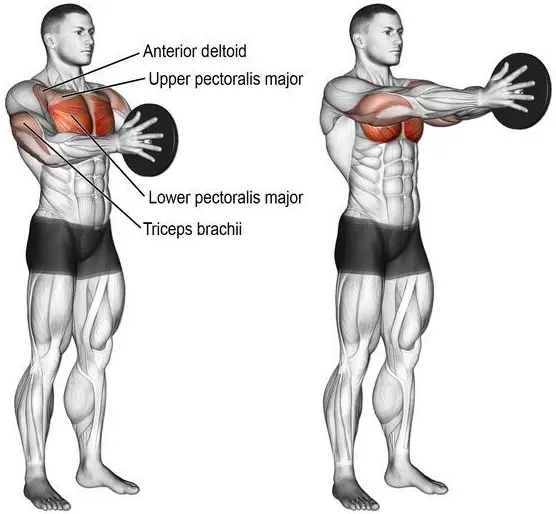
While we have no idea who Svend is or was, this exercise is an excellent alternative to the pec deck. While it IS a pressing exercise, your triceps aren’t all that involved, and your pecs must work extra hard to squeeze your arms inward. It’s a good alternative for the peck deck and is especially useful if you train at home and need a low-tech chest exercise to finish off your workout.
Find out how to do the Svend press here.
4. Dumbbell fly
No pec deck or cable crossover machine? You can also isolate your pecs with dumbbell flyes. The main disadvantage of dumbbell flyes over the pec deck is that muscle tension starts to drop as you bring your arms together. Your pecs are only under maximal tension when your arms are apart. That minor gripe aside, dumbbell flyes are a useful, old-school alternative to the pec deck.
There are three ways to do dumbbell flyes:
5. Floor slider chest fly
This exercise isolates your chest like the pec deck but uses your body weight for resistance. All you need for this exercise is a couple of slider discs and a smooth floor. No discs? Just use a couple of gym towels or microfiber dusters.
How to do it:
- Get down and into the push-up position, with your arms and body straight. Brace your abs.
- Smoothly push your hands apart and lower your chest down toward the floor. Keep your arms slightly bent but rigid. Do not allow your hips to drop out of alignment.
- Use your pecs to squeeze your arms together and return to the starting position.
- Make this exercise easier by resting on your knees or harder by wearing a weighted vest or raising your feet on a bench or step.
6. Suspension trainer/gymnastic ring fly
Suspension trainers and gymnastic rings are versatile exercise tools. Not only can you use them to replicate most gym exercises, but they’re also light and portable, so you can work out almost anywhere. Using a suspension trainer or gymnastic rings also increases stabilizer and core activation, making your workout more demanding and functional.
How to do it:
- Adjust the length of your suspension trainer/gymnastic rings to about waist height. Hold the handles with your hands together. Walk your feet back and into the push-up position, and brace your abs.
- Slowly open your arms and lower your chest down toward the floor.
- Use your pecs to squeeze your arms back together and return to the starting position.
- Adjust the angle of your body to alter the difficulty of this exercise. The more upright you are, the easier it will be. You can also wear a weighted vest or elevate your feet to make your workout more demanding.
7. Resistance band chest fly
Resistance bands are perfect for exercisers who travel. A set of bands weighs next to nothing, so you can toss them in your bag or suitcase and take them wherever you go. Resistance band chest flyes are a useful alternative to the pec deck when you can’t make it to the gym.
How to do it:
- Attach your band to a chest-high anchor. With your back to the anchor point, hold one end of the band in each hand, arms apart and roughly level with your shoulders. Adopt a staggered stance for stability and brace your abs.
- Keeping your arms slightly bent but rigid, bring your hands forward to meet in front of your chest.
- Open your arms and repeat.
- Alter the angle of your arms and torso to work different parts of your chest.
Wrapping Up
The pec deck is a very effective chest exercise. Because the weight and your movement are guided by the machine, you are free to focus on pushing your muscles to the limit. Unlike bench presses, taking the pec deck to failure is a pretty safe thing to do, and they’re also an excellent exercise for intensity-boosting drop sets.
No pec deck? There are plenty of similarly effective exercises you can do instead. Some are perfect for home training, as they don’t require much in the way of equipment.
While chest pressing exercises are important for building muscle size and strength, isolation exercises like the pec deck are also valuable. For best results, combine these training methods to develop your best pecs ever.
References:
1– ACE.org: ACE-Sponsored Research: Top 3 Most Effective Chest Exercises (source)
Interested in measuring your progress? Check out our strength standards for Bench Press, Incline Dumbbell Fly, Dumbbell Bench Press, and more.


